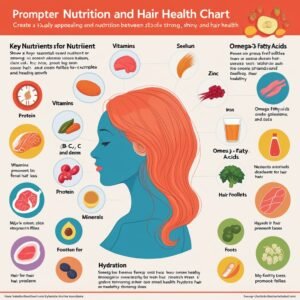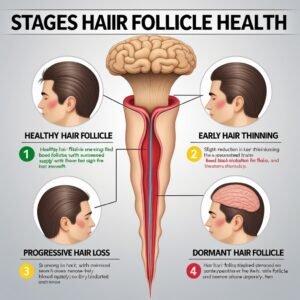
Portrait of a beautiful young woman brushing her hair in the bathroom at home
The Science of Hair Growth
How hair grows and what Influences it’s Growth :
The science of hair growth is a complex and fascinating subject that encompasses various biological processes occurring within the scalp and hair follicles. Understanding the mechanisms behind hair growth involves delving into the intricate interactions between genetics, hormones, cellular signaling pathways, and environmental factors. Here’s a simplified overview of the key aspects of the science of hair growth:
1. Hair Growth Cycle:
- Anagen Phase: This is the active growth phase of the hair follicle, during which hair grows steadily. The duration of the anagen phase varies depending on genetic factors, typically lasting between 2 and 7 years.
- Catagen Phase: In this transitional phase, hair growth stops and the hair follicle shrinks. This phase lasts for about 2 to 3 weeks.
- Telogen Phase: Also known as the resting phase, hair remains in the follicle without growing. After this phase, the old hair is shed, and the cycle begins anew.
2. Hair Follicle Structure:
- The hair follicle is a complex structure located beneath the scalp’s surface. It contains various components, including the dermal papilla, hair bulb, and matrix cells responsible for hair growth.
- Surrounding the follicle are sebaceous glands, which produce sebum, an oily substance that helps moisturize and protect the hair and scalp.
3. Cellular Processes:
- Hair growth is regulated by a combination of signals from hormones, growth factors, and neurotransmitters. These signals influence the activity of stem cells in the hair follicle, leading to hair growth or rest.
- Key regulators of hair growth include insulin-like growth factor 1 (IGF-1), vascular endothelial growth factor (VEGF), and various cytokines and prostaglandins.
4. Hormonal Influence:
- Hormones play a significant role in regulating hair growth. Androgens, such as testosterone and dihydrotestosterone (DHT), can either promote or inhibit hair growth, depending on their concentration and sensitivity in the hair follicles.
- Hormonal changes, such as those during puberty, pregnancy, and menopause, can affect the hair growth cycle and lead to temporary changes in hair density and texture.
5. Genetic Factors:
- Genetic predisposition plays a crucial role in determining hair growth patterns, hair texture, and susceptibility to conditions such as pattern hair loss (androgenetic alopecia).
- Specific genes involved in hair follicle development, hormone sensitivity, and hair cycle regulation have been identified through scientific research.






